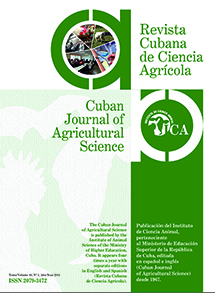Growth performance, carcass traits and economic response of broiler fed of palm kernel meal (Elaeis guineensis)
Contenido principal del artículo
Resumen
The objective of the study was to determine the growth performance, carcass traits and economic response of broiler chickens fed of palm kernel (Elaeis guineensis) meal (PKM). A total of 120 one-day-old Cobb-500® male chicks were evaluated for 47 days and were assigned to four dietary treatments using a completely randomized design. Dietary treatments consisted of a control diet (T0) and three other diets containing 100 (T1), 200 (T2) and 300 (T3) g/kg of PKM. Compared to birds fed T0, birds
fed T1 had no effect (P > 0.05) on the measured parameters of growth performance and carcass traits, birds fed T2 and T3 had higher feed intake (139.75-145.79 g/bird/day) (P < 0.05) and feed conversion (2.08-2.41) and birds fed T3 had lower (P < 0.05) final weight. In addition, T2 and T3 birds had lower (P < 0.05) carcass weight, breast weight and total viscera weight, whereas T3 birds had lower (P < 0.05) leg weight. Increasing levels of PKM in diets decreased (p < 0.05) the cost of consumed feed, the feed
cost to produce one kg of live weight, carcass, breast, and leg with economic utilities. These findings indicate that palm kernel can be used up to 100 g/kg in male broiler diets as partial replacement for corn and soybean meal, without affecting performance and carcass traits, however, inclusion of 300 g/kg of PKM had the best cost-benefit analysis.
Keywords: alternative feed, bioproductive indicator, chicken, cost-benefit relation
Detalles del artículo
Aquellos autores/as que tengan publicaciones con esta revista, aceptan los términos siguientes:
- Los autores/as conservarán sus derechos de autor y garantizarán a la revista el derecho de primera publicación de su obra, el cuál estará simultáneamente sujeto a la Licencia Creative Commons Attribution-NonCommercial 4.0 International (CC BY-NC 4.0) que permite a terceros compartir la obra siempre que se indique su autor y su primera publicación esta revista. Bajo esta licencia el autor será libre de:
- Compartir — copiar y redistribuir el material en cualquier medio o formato
- Adaptar — remezclar, transformar y crear a partir del material
- El licenciador no puede revocar estas libertades mientras cumpla con los términos de la licencia
Bajo las siguientes condiciones:
- Reconocimiento — Debe reconocer adecuadamente la autoría, proporcionar un enlace a la licencia e indicar si se han realizado cambios. Puede hacerlo de cualquier manera razonable, pero no de una manera que sugiera que tiene el apoyo del licenciador o lo recibe por el uso que hace.
- NoComercial — No puede utilizar el material para una finalidad comercial.
- No hay restricciones adicionales — No puede aplicar términos legales o medidas tecnológicas que legalmente restrinjan realizar aquello que la licencia permite.
- Los autores/as podrán adoptar otros acuerdos de licencia no exclusiva de distribución de la versión de la obra publicada (p. ej.: depositarla en un archivo telemático institucional o publicarla en un volumen monográfico) siempre que se indique la publicación inicial en esta revista.
- Se permite y recomienda a los autores/as difundir su obra a través de Internet (p. ej.: en archivos telemáticos institucionales o en su página web) antes y durante el proceso de envío, lo cual puede producir intercambios interesantes y aumentar las citas de la obra publicada. (Véase El efecto del acceso abierto).
